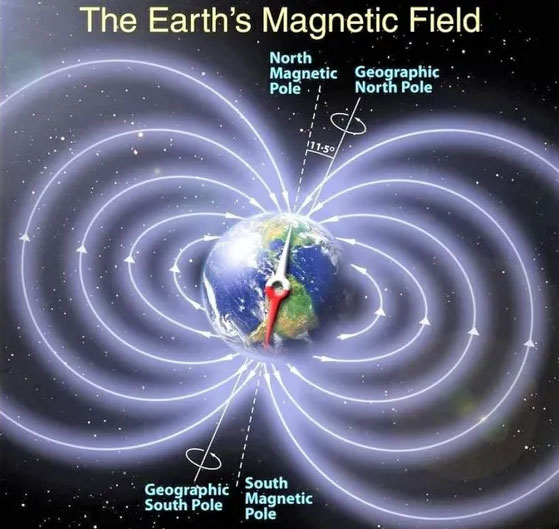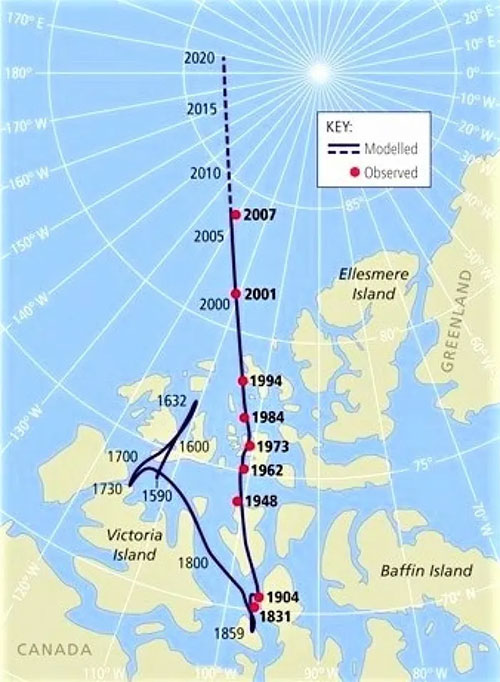Is the magnetic North Pole shift dangerous to humanity?
The Earth's magnetic north pole continues to shift for reasons that have not been fully explained by science. However, that teleportation is not really dangerous and is within human control.
Magnetic North Pole of the Earth
There are actually 8 types of North Poles, but people are interested in 3, namely the Geographic North Pole (the northernmost point of the Earth's imaginary axis of rotation), the Magnetic North Pole (the north end of a normally magnetized compass needle). points to; it does not coincide with the Geographic North Pole, but is close enough for navigation) and the Geomagnetic North Pole (currents generated by convection currents of moving molten metals that generate the magnetic fields of Earth, intensity varies from place to place underground).
The Earth's magnetic North Pole, where the magnetic lines entering the Earth are perpendicular to the Earth's surface, is a non-stationary position. The English philosopher William Gilbert first calculated the existence of the magnetic North Pole in 1590. By 1831, British naval officer James Clark Ross became the first person to actually approach it. Until 1898, the magnetic North Pole meandered through the islands and waterways of northern Canada.

The Magnetic North Pole and the Geographic North Pole are 11.5 degrees apart. (Source: popularmechanics.com).
But since 1898, it moves in a north-northwest direction. Travel speed in the early 20th century, about 5 miles/year; By the late 1940s, the magnetic North Pole had moved about 400 km to the northwest, and since 1970 - began to move faster. Currently, the magnetic North Pole moves about 25 miles a year; Since the 1990s, it has traveled about 970 km and is located in the middle of the Arctic Ocean.
As of February 2019, it is at 86.54°N, 170.88°E in Arctic waters. The magnetic North Pole will move into the Eastern Hemisphere towards Siberia in Russia. Soon it will be at 86.471°N and 178.755°W, less than 212 nautical miles from the Geographic North Pole. It is strange that the South Pole of the Earth does not rotate, has a relatively stable position. The magnetic South Pole also does not coincide with the Geographic South Pole, in February 2019 it was located at 64.13°South, 136.02°East off the Antarctic Sea.
Motion tracking in the Earth's core
Scientists have not been able to explain why the planet's magnetic field, which protects Earth from deadly solar winds, continues to shift and change, although the existing theory is based on the Barnett effect- Einstein has been quite productive for several decades. It has been suggested that the reason the North Pole moves about 25 miles a year is due to earthquakes, electrical fluctuations in the Van Allen radiation belts, ionosphere and magnetosphere, but much of it is due to physical structure. inside our planet.
The planet's magnetic field is generated deep within the Earth's core, about 3,200km above the ground. It is a mass of molten metal that is constantly rotating in the core of the Earth. Changes in that metal flow would alter the Earth's magnetic field lines and the magnetic poles where they converge. It is hypothesized that the 2016 geomagnetic pulsation in South America, which led to a change in the Earth's magnetic field structure, is the cause. Earth's magnetic field exists thanks to liquid nickel and iron in the planet's outer core, about 1,800 miles above the surface.
Scientists believe that the increased speed of the North Pole could signal the early stages of a geomagnetic field reversal, in which the North and South poles will flip and swap places. They say at least 184 geomagnetic field inversions have occurred in the past 83 million years, roughly every 100,000 to 1 million years, and these inversions typically take 1,000 to 10,000 years to complete. The last complete and permanent reversal happened 786,000 years ago, and it can happen in the span of a human lifetime.
A brief reversal occurred 41,000 years ago during the Ice Age, but it lasted only "440 years" before reverting. The hypothetical triggers of this periodic geomagnetic field reversal are extraterrestrial extinction-level impact events, continental-sized rock slabs sinking into the region between the mantle and the inner core. In addition to liquids, massive plate tectonics, etc. weaken the Earth's magnetic field, making field rearrangements more likely, and even lead to geomagnetic field inversions.

Since the 1900s, the magnetic North Pole has shifted northward. (Source: oceannavigator.com).
The displacement of the magnetic North Pole causes the World Magnetic Model (WMM) to monitor the field and notify compasses, smartphone GPS, and navigation systems on aircraft and ships incorrectly. . Traditionally, the WMM is updated every 5 years, as pole movements during this time period are fairly predictable. The final adjustments were made in 2015.
The North Magnetic Department is very important for navigation models
Like the European and US militaries, commercial airlines and smartphone GPS apps also use WMM-based navigation systems to help users determine their location and navigate accordingly. That's why the UK Geological Survey and the National Oceanic and Atmospheric Administration (US) update the WMM every five years.
However, on February 4, 2019, they had to update this model ahead of time because the movements of the magnetic North Pole were happening too fast. Updating is necessary so that the GPS system on smartphones, navigating aircraft, ships and military navigation devices can work most accurately.
The authors of a new study have got an idea of why the magnetic North Pole might move - and are looking to predict this change. The new maps also show the North Pole from shifting east of the prime meridian (running through the Royal Observatory in Greenwich, England) from September 2029 onwards. But even with these periodic updates, geomagnetic jerks make it difficult to keep the model accurate. And this requires making certain modifications to all navigation systems - from GPS to Google Maps on smartphones.
Some speculate that the reversal of the Earth's magnetic field has been going on for too long; Recent magnetic North Pole changes could be a sign of some impending magnetic field disaster. If we lose the magnetic field, we lose the atmosphere. But that's extremely unlikely, since the Earth's core won't stop spinning.
GPS systems have replaced most traditional equipment, but many people still often have to use compasses for navigation such as in cases under water or underground where communication with satellites is not possible. GPS. It is currently unknown whether the Earth's two magnetic poles will switch places or if the magnetic field will return to its previous stability. Both cases have occurred in history and have not affected the species much. However, modern navigation systems rely on the magnetic North Pole and will have to be recalibrated if the poles continue to shift.
- The pole from the North of the Earth is ... shifting
- The pole from the North is moving to Russia
- The solar field is about to turn polar
- In the future will the sun grow in the west?
- How does the compass tell us where the North pole is at the South Pole?
- Video: Earth has 3 north poles
- The Earth core pushes from the North to 60 km per year
- 1500 years from now Earth's magnetic field may be reversed
- The north pole from the Earth is moving
- The winter is prolonged due to the North Pole spiral moving
- Canada started drawing seabed maps around the North Pole
- Why did the North Pole move toward London?
 Washington legalizes the recycling of human bodies into fertilizer
Washington legalizes the recycling of human bodies into fertilizer Lightning stone - the mysterious guest
Lightning stone - the mysterious guest Stunned by the mysterious sunset, strange appearance
Stunned by the mysterious sunset, strange appearance Central in the hot 39 degrees Celsius
Central in the hot 39 degrees Celsius